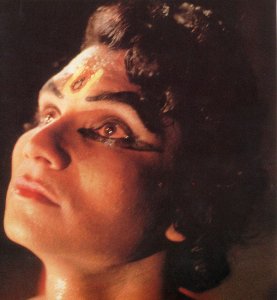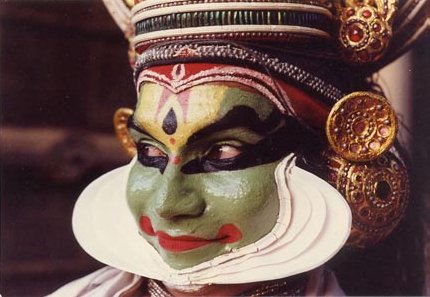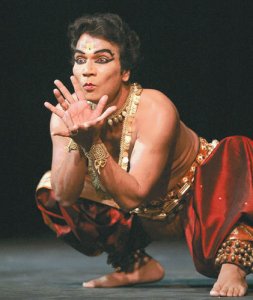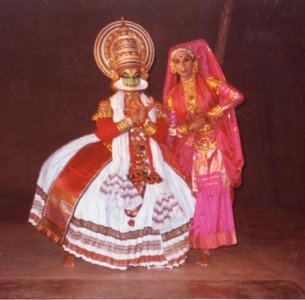
|
 |

|
 |
Rendezvous with Kathakali exponent Kottakkal Sasidharan Nair - Febina Mathew, Fargo, North Dakota e-mail: febina@gmail.com December 11, 2006 Kathakali discovered long ago that the secret of the Great Stories is that they have no secrets...In the Great Stories you know who lives, who dies, who finds love, who doesn't. And yet you want to know again. - Arundhati Roy (The God of Small Things. New York: Random House.1997: 218-219) Kerala, the land of pristine beauty and natural resources, hoary temples, wooded glades and lakes sets an unearthly mystical atmosphere for one of the oldest forms of dance drama tradition in the world- Kathakali. This efflorescent art form has been described as a one of the most magnificent theatres of the imagination. The internationally acclaimed artiste Kottakkal Sasidharan Nair brought to life one of his enthralling Kathakali experiences to Fargo (North Dakota, USA) with "Abhignana Sakuntala" or "The Recognition of Sakuntala" by Kalidasa. Sasidharan Nair sought Kathakali training in PSV Natya Sangham, Kottakkal, under the famous artist Kottakkal Krishnankutty Nair. Subsequently, he received training in Bharatanatyam and Kuchipudi from the world renowned Dr. Mrinalini Sarabhai, Founder-Director of Darpana Academy of Performing Arts, Ahmedabad. He also learned Koodiyattam under Kalamandalam Narayana Chakiyar. He has been a teacher, resident artist and member of faculty of Darpana Academy since 1973. Nair, now in his 50s, has performed in countries as far-flung as Europe, Japan, Australia and Mexico. The artiste arrived in Fargo at the invite of Prof. Paul Lifton (Department of Theatre Arts at the North Dakota State University (NDSU)), to supervise "The Recognition of Sakuntala." Sasidharan Nair shares his experiences and NDSU showcase of Kathakali. Kathakali, literally meaning 'story-play,' is a dance-drama that originated in the 17th century in Kerala. Two other dance forms Koodiyattom and Krishnattam have influenced in the making of Kathakali. Kathakali evolved as an independent pantomime art from a number of native martial, ritualistic and socio-religious elements. Kathakali can be said to be the sweet fruit of a blend of all Indian theatre traditions including Koodiyattom, Krishnattam and the indigenous folk dance forms. Beginning in antiquity and deep rooted in native traditions, this dance form is a vibrant force and a class by itself. What is the life of a Kathakali actor: the first steps in learning Kathakali, the main stages of his studies? Kathakali is a poor man's rich art. Their early life was a struggle, always deprived of chances to earn stage experience, as Kathakali performances were mostly confined to temple precincts. Most artists (including Padmabhushan and Padmashree awardees) hail from a poor background. When I was 9 years old, my parents ran out of money to send me to school, so they signed me up for dance school, where Kathakali dance was free. School started at 3am, with practice of the glaring, rapid blinking and other eye movements central to this storytelling dance form. Then, there were body exercises, dance lessons and study of the elaborate sign language at the heart of the dance until 9pm. I underwent this training for eight years. Make-up in Kathakali also required rigorous training. Further, the Kathakali dancers are also required to have a through knowledge of literature including Puranas and Ithihasas (epics and mythologies). 'Arangetram' is possible in six months or even three years. But, only through continuous rehearsals, one can make a mark in Kathakali. 
 Kathakali is poor man's rich art. Does that mean the art does not have a ready mass appeal? Art or kala is a golden thread embellished in literature, dance, music, theater, poetry that connect people. And Kathakali requires a thorough proficiency of the art. Hence, one cannot attain popularity in Kathakali by publicity or high influence. He or she has to come up by virtue of merit and sheer hard work. Today, people around the globe come to Kerala or India to learn the tradition. In fact, a student from London (Julian) was encouraged by my performance to learn Kathakali. There are few American students from NDSU, whom I coached for Sakuntala, wanting to come to Kerala to seek Kathakali training. Hence, I wouldn't say the number of enthusiasts wanting to learn the art has gone down. However, audience or youngsters still prefer Bharatanatyam or Kuchipudi. A Kathakali artist improvises his dance skills by observation or imagination, besides his regular rehearsals. Unlike Bharatanatyam or other dance styles, where the dance may be pre-choreographed, Kathakali requires apt expression of the emotions (lasyams) that can come only with skill. He needs to observe or look around to achieve the apt expression. For instance, I performed a combat between a lion and a python. The dance began with the stately walk of the lion and the wave of the hands to portray the slithery python. The next was the demeanor of the lion showing fear as he comes upon the python. But the lion is king-of-the-jungle. So his expressions now become daring to confront the python. A roaring sound was made to portray the lion's ferocious attack on the python. Now, without observation or imagination, it is not easy to express the lion or python. The actor in Kathakali never speaks. The text of the drama is sung for him and is the baseline for his interpretation. It is in histrionics or interpretive dancing that the Kathakali artist excels. You have used subtle yet graceful Bharatanatyam movements in your recent NDSU showcase of Kathakali 'Abhignana Sakuntala' by Kalidasa; 'Christ'; 'Krishna Katha'; 'Ramayana'; and the piece you mentioned on the combat of lion and the python. Are you open to experimenting Kathakali? The Natya Shastra reads, "This art is not merely for your pleasure, but exhibits cosmic expression (bhava) for all the worlds...it is replete with the diverse moods, informed with varying passions of the soul, and linked to the deeds of mankind." To be brief, Natya Shastra has not laid a set rule for any dance tradition. There is no language barrier that Kathakali should be performed only in Malayalam or Sanskrit. I have performed in Gujarati, Bengali etc. However, irrespective of the language or whether the dance base is Bharatanatyam or Kathakali, I adopt dance movements that can help audience easily understand the characters in my dance works. 

Your dance production 'Abhignana Sakuntala' at NDSU had only American performers. Did you find any difference in approach to dance by foreign students as compared to Indian students? A quote from Natya Shastra states, "Dharma Yashashya Mayushyha, Hittham buddhi vivardhanam, Lokopadesh Jannanam Natyamethad Bhavishyathi" - The art of dance promotes virtue, heals the sick; it assures sustenance, luck in the chase, victory in battle; brings fame and longevity, provides benefit, increases intelligence and contains proper advice to the world. But, to become a dance artiste some measure of inborn talent is essential. Training and guidance can only hone existing talent. So, irrespective of whether the student is of foreign or Indian origin, one should have the talent, commitment, sacrifice and a total unquestioning dedication to the art. In general, what did you think about NDSU's 'Abhignana Sakuntala' (The Recognition of Sakuntala)? I have attained anandam or complete satisfaction. Students were very enthusiastic, supportive, patient during the course of my training and gifted me a boon by doing a great show and performing to the best of their ability. Prof. Paul Lifton also deserves kudos for his exceptional direction and patience. Present stance and future of Kathakali? Kathakali is well appreciated today because of its magnificence, though the artists have contributed further by taking it worldwide. Movies based on Kathakali such as Adoor Gopalakrishnan's 'Kalamandalam Raman Kutty Nair' or Shaji Karun's 'Vanaprastham' have received global recognition. Such movies have rightly depicted the typical life of a Kathakali artist. In fact, the other day when I was in Minneapolis performing to 'Krishna Katha: An offering to Lord Vishnu' at the Hindu temple, Minnesota, a lady from Montréal, came especially to see my performance because she was moved by Mohanlal's acting skills and his Kathakali in 'Vanaprastham.' At the same time, I also think the art form can get extinct, without a proper support system, finance or interest. At present, along with my work at Darpana, I have my own creative workshop, the Srushti Foundation that was started to financially help young Kathakali artists to start their career and find a secure footing in this highly commoditized art-world. I am currently supporting three to four students (boys mostly, there is also a Muslim girl Rubiya who hails from one of the poorest family in Kerala). Most of their financial aid comes from my income. A few Indians in US have come forward to sponsor one or two young Kathakali artists. I think there should be a Department of Dance and Theatre Arts, at governmental and institutional levels, especially in Kerala, like they have in Western Countries or even Kolkata for that matter. The art will not only have continued financial support but also attract youngsters to earn a degree in Bharatanatyam, Kathakali etc for a better future. The responsibility to keep our country's heritage alive lies in our hands. Contact: Kottakkal Sasidharan Nair Madhavam, 8-Sabandh Thalltej, Ahmedabad 380059 Gujarat, India Ph: (91- 79) - 26850793 e-mail: sasi@kottakkal.sasidharan.com Febina Mathew is a Bharatanatyam dancer / writer based in Fargo, North Dakota. |